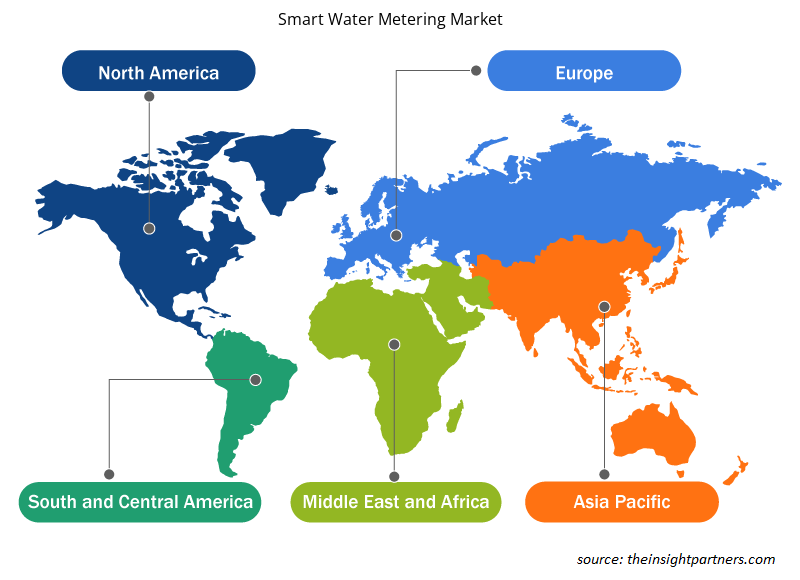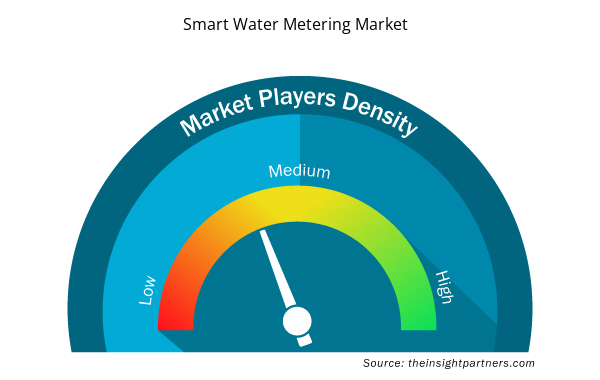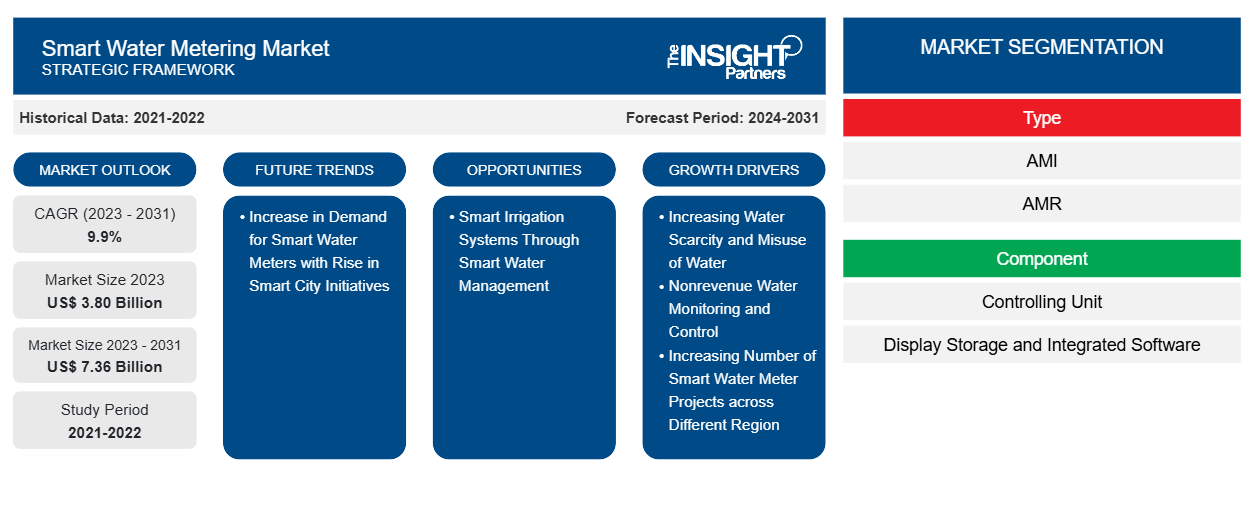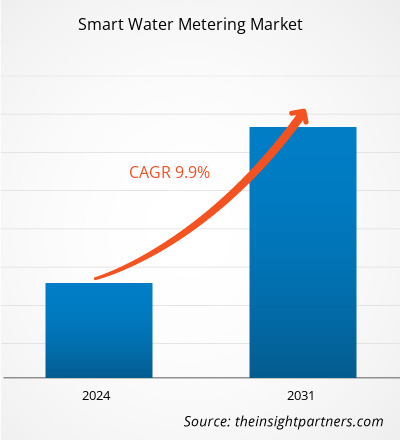スマート水道メーター市場規模は、2023年の38億米ドルから2031年には73億6,000万米ドルに達すると予測されています。市場は2023年から2031年の間に9.9%のCAGRを記録すると予想されています。スマートシティイニシアチブの増加に伴うスマート水道メーターの需要の増加は、予測期間中、市場の主要なトレンドであり続ける可能性があります。
スマート水道メーター市場分析
いくつかの政府の取り組みは、現在の状況でスマート水道メーター市場が繁栄するのに役立っています。たとえば、北米のいくつかの地域では、政府の資金援助を受けてスマート水道メーターの実装に成功しています。また、この地域の多くの市当局は、既存のスマート水道メーター インフラストラクチャの新規設置または近代化のためのいくつかのプロジェクトを立ち上げています。2021 年 11 月、テキサス州ウィルマー市は、市の水道サービス インフラストラクチャを近代化するために、880,780 米ドル相当のスマート水道メーター近代化プロジェクトの開始を発表しました。このプロジェクトの主な目的は、住宅の顧客がリアルタイムで水道使用量データにアクセスできるようにし、運用効率を向上させることです。これにより、水道メーターの読み取り精度が向上し、水道伝送サービス プロバイダーとエンド ユーザーへの請求も正確になります。
スマート水道メーター市場の概要
水道事業者や水道事業体は、あらゆる地域に十分な量の水を供給するために、常にさまざまな技術を採用しています。また、運用コストの削減、資産管理、節水の促進にも役立ちます。エンドユーザーのうち、先進国や発展途上国の住宅部門は、水の消費パターンを監視および確認するために、技術的に高度な水道メーターを採用しています。スマート水道メーターは、パイプラインの漏れ、改ざん行為、逆流を防ぐことで住宅地域にも役立ち、水の損失とそれに伴う損失を減らします。産業部門は、割り当てられた水の量、最後に供給された水の量、期間の終わりに請求された水の量を理解するのに役立つため、スマート水道メーターを使用して水道システムをアップグレードしています。スマート水道メーターは、水の消費の非効率性とパターンを検出できます。これらのメーターには、各消費者の水の使用状況を定期的に追跡する IoT センサーが含まれています。センサースイートによって生成されたデータは、さらに監視できるため、公益事業体と顧客は消費習慣をよりよく理解し、過剰な水を使用している領域を特定できます。これにより、過剰な水の消費と無駄が減少します。非収益水道料金の発生を減らすために、業界はますますスマート水道メーターを導入しており、市場の拡大につながっています。
要件に合わせてレポートをカスタマイズする
このレポートの一部、国レベルの分析、Excelデータパックなど、あらゆるレポートを無料でカスタマイズできます。また、スタートアップや大学向けのお得なオファーや割引もご利用いただけます。
- このレポートの主要な市場動向を入手してください。この無料サンプルには、市場動向から見積もりや予測に至るまでのデータ分析が含まれます。
スマート水道メーター市場の推進要因と機会
無収水監視と制御
無収水とは、生産された水の量と顧客に請求される水の量の差です。水源から目的地までの水の損失は、漏水(物理的損失)や計測ミス、操作、盗難(見かけ上の損失)など、さまざまな理由で発生します。無収水は指数関数的に増加しており、水不足やその他の懸念を引き起こしています。調査によると、平均して、北米では毎年、水の盗難や違法な取水が無収水の8%を占めています。国際水協会(IWA)の最近の調査によると、世界の水の浪費は、顧客に届くまでの配水ネットワークで1日あたり約3億4,600万立方メートル、年間1,260億立方メートルに上ります。このような損失は無収水とも呼ばれ、北米の平均水道コストとして年間約390億米ドルに上ります。無収水のトラブルシューティングの必要性から、さまざまな政府によって一般的に承認されているスマート水道メーターなどのいくつかの技術の開発が必要になりました。スマート水道メーターは、漏水や損失に関する 1 時間ごとのデータと、発生日時を記録します。このシステムでは、オペレーターが現場または任意のプラットフォームから取得したデータを確認することもできます。多くのスマート水道メーターには、パイプラインの盗難や改ざんの可能性を減らすためのアラームが含まれています。これらの警告システムは、エンドユーザーの場所から収益を生み出すのに役立ちます。無収水の監視、制御、削減に対する需要の高まりにより、業界の企業は堅牢なテクノロジーを革新および設計するようになり、スマート水道メーター市場の成長を促進しています。
スマートな水管理によるスマート灌漑システム
スマート灌漑またはスマート農業は、十分な農地がある地域であるため、北米とヨーロッパで繁栄している分野です。しかし、従来の農業形態には人手と時間が足りません。スマート農業またはスマート灌漑システムには、複数のセンサー、データロガー、通信システムに加えて、オペレーターが手順を簡単に確認できるデータプラットフォームの使用が含まれます。北米とヨーロッパ諸国の農業業界の上記の傾向と、個々のセンサー、データロガー、およびその他のコンポーネントの価格の高騰に関連して、農家または農業組織は、敷地内にスマート水道メーターを導入しています。スマートメーター技術を灌漑システムに統合して、景観と農業の水の消費量を監視および管理できます。スマート灌漑コントローラーとセンサーは、ユーザーが水の使用を最適化し、水の無駄を避けるのに役立ちます。これにより、灌漑が主要な水消費源である地域では、大幅な節水が可能になります。さらに、スマート水道メーターは、すべての個々のコンポーネントを1つのユニットに結合することで農家または農業組織に利益をもたらし、その結果、会社の初期費用を削減します。これらのメーターは、農家や農業組織のエネルギー管理、水の使用、節水を促進し、最終的にはコストを節約します。灌漑や農業におけるスマート水道メーターの利点は、必要な水の量を感知し、必要な量を散布することです。これにより時間が短縮され、人的労力が最小限に抑えられ、精度が向上し、高品質の作物収穫量が得られます。節水における技術の進歩は、米国、カナダ、メキシコ、ドイツ、フランス、英国、イタリア、オーストラリアなどの国の農業産業に大きな利益をもたらしています。灌漑におけるスマート技術の採用率の高さは、今後数年間でスマート水道メーター市場の成長を促進すると予想されます。
スマート水道メーター市場レポートのセグメンテーション分析
スマート水道メーター市場分析の導出に貢献した主要なセグメントは、タイプ、コンポーネント、エンドユーザー、メータータイプです。
- タイプに基づいて、スマート水道メーター市場は AMR と AMI に分かれています。自動メーター読み取りセグメントは 2023 年に大きな市場シェアを占めました。
- コンポーネントに基づいて、市場は制御ユニット、ディスプレイ、ストレージ、統合ソフトウェア、その他に分かれています。ディスプレイ、ストレージ、統合ソフトウェアセグメントは、2023年に最大の市場シェアを占めました。
- エンドユーザー別に見ると、スマート水道メーター市場は住宅用と産業用に分かれています。2023年には住宅用セグメントがより大きな市場シェアを占めました。
- メーターの種類別に見ると、市場は超音波メーター、電磁メーター、電気機械メーターに分類されます。超音波メーターセグメントは、2023年に最大のスマート水道メーター市場シェアを占めました。
スマート水道メーター市場シェアの地域別分析
スマート水道メーター市場レポートの地理的範囲は、主に北米、アジア太平洋、ヨーロッパ、中東およびアフリカ、南米および中米の 5 つの地域に分かれています。
2023年には北米が大きな市場シェアを占めました。北米は米国、カナダ、メキシコで構成されています。米国は、近代技術の導入、生活水準、インフラ整備などの面で先進国です。また、水インフラ整備に関する手頃な価格の懸念は重大な段階に達しています。米国環境保護庁(EPA)は、2つの州回転基金プログラム、クリーンウォーター州回転基金(CWSRF)と飲料水州回転基金(DWSRF)を管理しています。さらに、DWSRFは連邦政府と州政府によって共同出資されており、それぞれ80%と20%です。
水道業界の投資家は、ネットワーク全体の最適化ではなく、主にスマートメーターの設置とデータ収集および可視化をサポートするために、機会を捉えたアップグレードに重点を置いています。この地域の政府は、頑固な水使用量を削減し、近代化を進め、古い水道メーターを最先端のスマート水道メーターに交換するための対策を継続的に講じており、これは北米で大きなトレンドになりつつあります。
スマート水道メーター市場の地域別分析
予測期間を通じてスマート水道メーター市場に影響を与える地域的な傾向と要因は、Insight Partners のアナリストによって徹底的に説明されています。このセクションでは、北米、ヨーロッパ、アジア太平洋、中東、アフリカ、南米、中米にわたるスマート水道メーター市場のセグメントと地理についても説明します。

- スマート水道メーター市場の地域別データを入手
スマート水道メーター市場レポートの範囲
| レポート属性 | 詳細 |
|---|---|
| 2023年の市場規模 | 38億ドル |
| 2031年までの市場規模 | 73.6億米ドル |
| 世界のCAGR(2023年~2031年) | 9.9% |
| 履歴データ | 2021-2022 |
| 予測期間 | 2024-2031 |
| 対象セグメント | タイプ別
|
| 対象地域と国 | 北米
|
| 市場リーダーと主要企業プロフィール |
|
市場プレーヤーの密度:ビジネスダイナミクスへの影響を理解する
スマート水道メーター市場は、消費者の嗜好の変化、技術の進歩、製品の利点に対する認識の高まりなどの要因により、エンドユーザーの需要が高まり、急速に成長しています。需要が高まるにつれて、企業は提供を拡大し、消費者のニーズを満たすために革新し、新たなトレンドを活用し、市場の成長をさらに促進しています。
市場プレーヤー密度とは、特定の市場または業界内で活動している企業または会社の分布を指します。これは、特定の市場スペースに、その市場規模または総市場価値に対してどれだけの競合相手 (市場プレーヤー) が存在するかを示します。
スマート水道メーター市場で事業を展開している主要企業は次のとおりです。
- アラド株式会社
- バジャーメーター株式会社
- Bmeters SRL
- ディール財団
- アイトロン株式会社
- カムストルプ AS
免責事項:上記の企業は、特定の順序でランク付けされていません。

- スマート水道メーター市場のトップキープレーヤーの概要を入手
スマート水道メーター市場のニュースと最近の動向
スマート水道メーター市場は、主要な企業出版物、協会データ、データベースなどの一次調査と二次調査後の定性的および定量的データを収集することで評価されます。スマート水道メーター市場におけるいくつかの開発を以下に挙げます。
- メキシコ全土の水道事業者は、2011 年に Xylem の AMI ソリューションを導入しました。さらに、2022 年には、水圧データを収集するために、FlexNet 通信ネットワークを介してクラウドホスト型の Sensus アナリティクスと住宅用水道メーターを追加導入しました。(出典: Sensus USA Inc、プレスリリース、2022 年 7 月)
- Neptune Technology Group Inc. は、北米全域で運用されている住宅用および中級用 MACH 10 メーターの拡張として、商業および産業 (C&I) アプリケーション向けの MACH 10 超音波水道メーターの発売を発表しました。(出典: Neptune Technology Group Inc.、プレスリリース、2022 年 6 月)
スマート水道メーター市場レポートの対象範囲と成果物
「スマート水道メーター市場の規模と予測(2021~2031年)」レポートでは、以下の分野をカバーする市場の詳細な分析を提供しています。
- スマート水道メーター市場の規模と予測(対象範囲に含まれるすべての主要市場セグメントについて、世界、地域、国レベルで)
- スマート水道メーター市場の動向、および推進要因、制約、主要な機会などの市場動向
- 詳細なPESTおよびSWOT分析
- 主要な市場動向、世界および地域の枠組み、主要プレーヤー、規制、最近の市場動向を網羅したスマート水道メーター市場分析
- 市場集中、ヒートマップ分析、主要プレーヤー、スマート水道メーター市場の最近の動向を網羅した業界展望と競争分析
- 詳細な企業プロフィール
- 過去2年間の分析、基準年、CAGRによる予測(7年間)
- PEST分析とSWOT分析
- 市場規模価値/数量 - 世界、地域、国
- 業界と競争環境
- Excel データセット



Report Coverage
Revenue forecast, Company Analysis, Industry landscape, Growth factors, and Trends

Segment Covered
This text is related
to segments covered.

Regional Scope
North America, Europe, Asia Pacific, Middle East & Africa, South & Central America

Country Scope
This text is related
to country scope.
よくある質問
The smart water metering market was valued at US$ 3.80 billion in 2023 and is projected to reach US$ 7.36 billion by 2031; it is expected to grow at a CAGR of 9.9% during 2023–2031.
Increasing water scarcity, misuse of water and nonrevenue water monitoring and control and increasing number of smart water meter projects across different region are the driving factors impacting the smart water metering market.
Europe is anticipated to grow with the highest CAGR over the forecast period 2024-2031.
The key players, holding majority shares, in smart water metering market includes Badger Meter Inc, Sensus USA Inc., Itron Inc., Mueller Water Products Inc., and Kamstrup AS.
Increase in demand for smart water meters with rise in smart city initiatives is the future trends of the smart water metering market.
The Europe held the largest market share in 2023, followed by North America.
Trends and growth analysis reports related to Electronics and Semiconductor : READ MORE..
The List of Companies - Smart Water Metering Market
- Kamstrup AS
- Mueller Water Products Inc
- Badger Meter Inc
- Itron Inc
- Neptune Technology Group Inc
- Arad Ltd
- Sensus USA Inc
- WAVIoT Integrated Systems LLC
- Bmeters SRL
- Diehl Stiftung & Co KG
The Insight Partners performs research in 4 major stages: Data Collection & Secondary Research, Primary Research, Data Analysis and Data Triangulation & Final Review.
- Data Collection and Secondary Research:
As a market research and consulting firm operating from a decade, we have published and advised several client across the globe. First step for any study will start with an assessment of currently available data and insights from existing reports. Further, historical and current market information is collected from Investor Presentations, Annual Reports, SEC Filings, etc., and other information related to company’s performance and market positioning are gathered from Paid Databases (Factiva, Hoovers, and Reuters) and various other publications available in public domain.
Several associations trade associates, technical forums, institutes, societies and organization are accessed to gain technical as well as market related insights through their publications such as research papers, blogs and press releases related to the studies are referred to get cues about the market. Further, white papers, journals, magazines, and other news articles published in last 3 years are scrutinized and analyzed to understand the current market trends.
- Primary Research:
The primarily interview analysis comprise of data obtained from industry participants interview and answers to survey questions gathered by in-house primary team.
For primary research, interviews are conducted with industry experts/CEOs/Marketing Managers/VPs/Subject Matter Experts from both demand and supply side to get a 360-degree view of the market. The primary team conducts several interviews based on the complexity of the markets to understand the various market trends and dynamics which makes research more credible and precise.
A typical research interview fulfils the following functions:
- Provides first-hand information on the market size, market trends, growth trends, competitive landscape, and outlook
- Validates and strengthens in-house secondary research findings
- Develops the analysis team’s expertise and market understanding
Primary research involves email interactions and telephone interviews for each market, category, segment, and sub-segment across geographies. The participants who typically take part in such a process include, but are not limited to:
- Industry participants: VPs, business development managers, market intelligence managers and national sales managers
- Outside experts: Valuation experts, research analysts and key opinion leaders specializing in the electronics and semiconductor industry.
Below is the breakup of our primary respondents by company, designation, and region:

Once we receive the confirmation from primary research sources or primary respondents, we finalize the base year market estimation and forecast the data as per the macroeconomic and microeconomic factors assessed during data collection.
- Data Analysis:
Once data is validated through both secondary as well as primary respondents, we finalize the market estimations by hypothesis formulation and factor analysis at regional and country level.
- Macro-Economic Factor Analysis:
We analyse macroeconomic indicators such the gross domestic product (GDP), increase in the demand for goods and services across industries, technological advancement, regional economic growth, governmental policies, the influence of COVID-19, PEST analysis, and other aspects. This analysis aids in setting benchmarks for various nations/regions and approximating market splits. Additionally, the general trend of the aforementioned components aid in determining the market's development possibilities.
- Country Level Data:
Various factors that are especially aligned to the country are taken into account to determine the market size for a certain area and country, including the presence of vendors, such as headquarters and offices, the country's GDP, demand patterns, and industry growth. To comprehend the market dynamics for the nation, a number of growth variables, inhibitors, application areas, and current market trends are researched. The aforementioned elements aid in determining the country's overall market's growth potential.
- Company Profile:
The “Table of Contents” is formulated by listing and analyzing more than 25 - 30 companies operating in the market ecosystem across geographies. However, we profile only 10 companies as a standard practice in our syndicate reports. These 10 companies comprise leading, emerging, and regional players. Nonetheless, our analysis is not restricted to the 10 listed companies, we also analyze other companies present in the market to develop a holistic view and understand the prevailing trends. The “Company Profiles” section in the report covers key facts, business description, products & services, financial information, SWOT analysis, and key developments. The financial information presented is extracted from the annual reports and official documents of the publicly listed companies. Upon collecting the information for the sections of respective companies, we verify them via various primary sources and then compile the data in respective company profiles. The company level information helps us in deriving the base number as well as in forecasting the market size.
- Developing Base Number:
Aggregation of sales statistics (2020-2022) and macro-economic factor, and other secondary and primary research insights are utilized to arrive at base number and related market shares for 2022. The data gaps are identified in this step and relevant market data is analyzed, collected from paid primary interviews or databases. On finalizing the base year market size, forecasts are developed on the basis of macro-economic, industry and market growth factors and company level analysis.
- Data Triangulation and Final Review:
The market findings and base year market size calculations are validated from supply as well as demand side. Demand side validations are based on macro-economic factor analysis and benchmarks for respective regions and countries. In case of supply side validations, revenues of major companies are estimated (in case not available) based on industry benchmark, approximate number of employees, product portfolio, and primary interviews revenues are gathered. Further revenue from target product/service segment is assessed to avoid overshooting of market statistics. In case of heavy deviations between supply and demand side values, all thes steps are repeated to achieve synchronization.
We follow an iterative model, wherein we share our research findings with Subject Matter Experts (SME’s) and Key Opinion Leaders (KOLs) until consensus view of the market is not formulated – this model negates any drastic deviation in the opinions of experts. Only validated and universally acceptable research findings are quoted in our reports.
We have important check points that we use to validate our research findings – which we call – data triangulation, where we validate the information, we generate from secondary sources with primary interviews and then we re-validate with our internal data bases and Subject matter experts. This comprehensive model enables us to deliver high quality, reliable data in shortest possible time.


 このレポートの無料サンプルを入手する
このレポートの無料サンプルを入手する